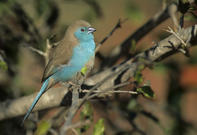
Name
Blue waxbill (Uraeginthus anolensis)
Blue Waxbill Appearance
The blue waxbill has a pale blue belly, rump and upper chest, extending on to the face. The back, crown and back of the head are light brown. The bill is a grey/pink colour and typically seed eater shape. The female is the same, but her belly is more off white.
This is a small bird at around 12 cm in length.
This is the only small bird found in South Africa with blue underparts.
Blue Waxbill Diet
The blue waxbill feeds mostly on small seeds, but will eat small fruit and insects. This waxbill is very dependent on water and needs to drink regularly.
Blue Waxbill Breeding
The blue waxbill is monogamous. The nest is a ball shaped grass structure, with a side entrance, placed in a thorny tree. The female lays between two and seven eggs, that hatch after around 12 days. The chicks will leave the nest and their parents at around 21 days from hatching.
Blue Waxbill Nests
Blue waxbills construct their delicate ball-like nests from the finest of grass materials, usually blue seed grass, Tricholaena monachne. These are carefully placed in the outer branches of thorn trees and shrubs, which offer the nesting pair a degree of protection from predators. Blue waxbills also often build in proximity to active wasp nests to further ward off would-be predators.
By Megan Emmet
Blue Waxbill Behaviour
The blue waxbill is found in flocks of up to 40 birds outside of the breeding season. These wax bills feed mainly on the ground and look like they are constantly on the move.
Threats
None.
Distribution and Habitat
The blue waxbill's main habitat is acacia thickets, in semi-arid to arid savanna. This waxbill needs permanent surface water for drinking. The blue waxbill can be found in the northeastern parts of South Africa.